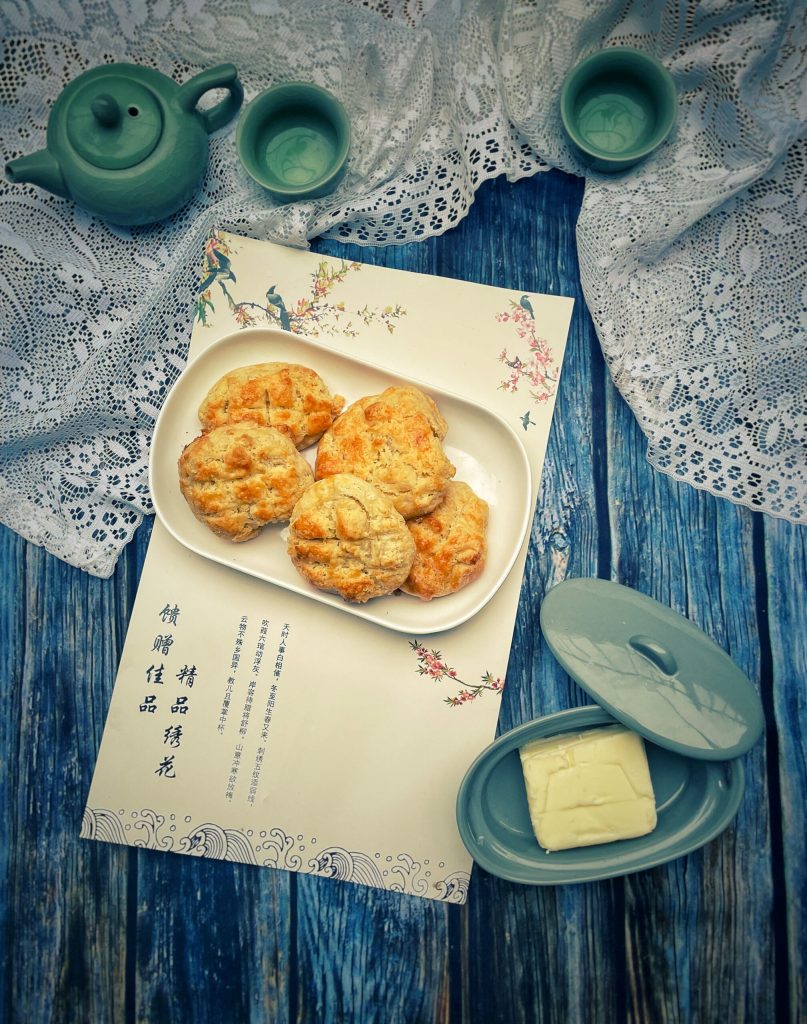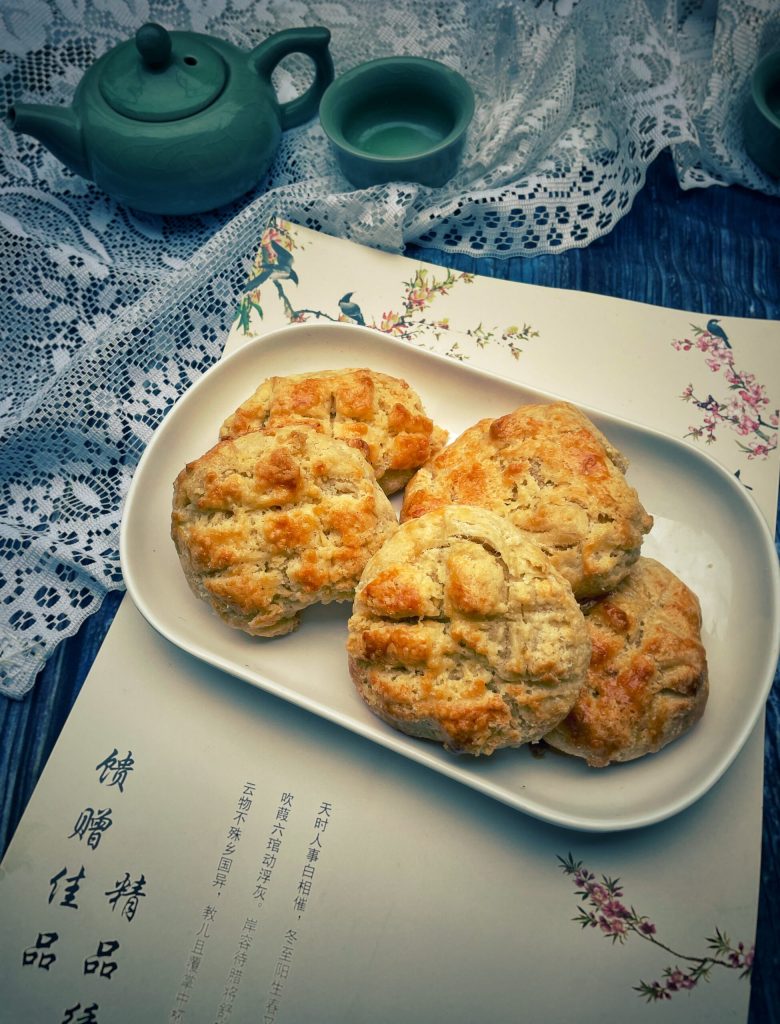The Bōluó bāo, 菠蘿包, known as “pineapple bun“, is an iconic sweet bread from Cantonese pastry, originating in Hong Kong in the 1960s.
Its origins date back to the mid-20th century, created as a bread for the working class and influenced by the fusion of British and Cantonese culinary traditions.
Despite the name, it does not contain pineapple; the name comes from the golden, cracked crust resembling the surface of a pineapple.
Traditionally, the crust is made with flour, sugar, eggs, and butter, giving it a crumbly texture and rich flavor.
It can be enjoyed in various versions:
菠蘿油 Bōluó yóu: a popular version where the warm bun is cut in half and filled with a slice of cold butter, which melts slightly, creating a delicious contrast of hot and cold.
Sweet fillings: some versions include fillings like custard, red bean paste, or coconut cream.
Savory fillings: modern variations may include savory fillings such as barbecue pork (叉燒), offering a balance between sweet and savory.
The Bōluó bāo is a symbol of Hong Kong’s culinary culture, often consumed at breakfast or as an afternoon snack, accompanied by a cup of Hong Kong-style milk tea.

- Difficulty: Medium
- Cost: Economical
- Rest time: 1 Hour 30 Minutes
- Preparation time: 15 Minutes
- Portions: 8 Pieces
- Cooking methods: Electric oven, Oven
- Cuisine: Chinese
Ingredients
- 2 1/2 cups flour
- 1 tsp baking powder
- 1/2 tsp salt
- 1 egg
- 1/2 cup milk (warm)
- 2 tbsps butter (soft)
- 1/4 cup sugar
- 1/4 cup butter (soft)
- 2/3 cup powdered sugar
- 1 egg yolk (+ for brushing)
- 3/4 cup flour
- 1/2 tsp baking powder
- 1/2 tsp vanilla extract
Steps
Dough Preparation:
In a large bowl, mix the flour, sugar, salt, and baking powder.
Add the egg and warm milk, kneading until a smooth mixture is obtained.
Incorporate the softened butter and continue kneading until a smooth and elastic dough is obtained.
Cover the dough and let it rise in a warm place for about 1 hour, or until doubled in size.
Crust Preparation:
In a bowl, mix the butter with the powdered sugar until creamy.
Add the egg yolk, vanilla extract, and mix well.
Incorporate the flour and baking powder, mixing until a soft dough forms.
Divide the crust dough into equal portions and form into balls.
After rising, divide the bread dough into equal portions and form into balls (8).
Slightly flatten each ball and place a ball of crust dough on top, gently flattening to cover the upper surface.
Use a sharp knife to score a grid pattern on the crust, simulating the appearance of a pineapple.
Place the buns on a baking sheet lined with parchment paper, cover, and let rise for another 30 minutes.
Preheat the oven to 350°F.
Gently brush the surface of the buns with some beaten egg yolk to achieve a shiny finish.
Bake for 15-20 minutes, or until the crust is golden and the bread is cooked.
Popular Variations:
Mini buns: bite-sized, perfect for snacks or dim sum.
Filled Versions:
Red bean paste (紅豆餡): a classic East Asian filling, slightly sweet and earthy.
Custard (奶黃): rich and creamy, made with egg yolks, milk, and sugar.
Sweet shredded coconut (椰絲): similar to the cocktail bun filling, sweetened and aromatic.
Char siu (叉燒): Cantonese-style grilled pork, for a savory contrast.
With Spam: a more modern and savory version, with Spam-style meat inserted into a sliced pineapple bun.
These are not just flavor variations: each version has become an integral part of Hong Kong’s cha chaan teng culture, often enjoyed with milk tea.
FAQ (Frequently Asked Questions)
Does the salty version of the pineapple bun also include sugar?
Yes, even in the salty version of the Bōluó bāo (such as the one with char siu filling or with Spam meat), the sweet crust remains unchanged: it’s a distinctive part of the bun.
The sweetness of the crust intentionally contrasts with the salty filling, creating a sweet & savory effect that is much appreciated in Hong Kong cuisine.
Therefore, the sugar is not eliminated, even in the savory versions.Does the Pineapple bun recipe resemble that of the novias de pan dulce?
Yes, the Bōluó bāo recipe has similarities with the Mexican “novias” (a variant of pan dulce), especially due to the sweet and crumbly crust that closely resembles the concha.
Main similarities:
Both are soft leavened buns.
They have a crunchy and sweet topping made with flour, sugar, and fat (butter or lard).
The crust is scored or shaped before baking to create a distinctive visual effect.
Differences:
The Bōluó bāo has a cookie-like crust, more compact and less airy than the concha.
The novias (like conchas) often use lard or margarine, while the traditional Bōluó bāo uses butter.
The Bōluó bāo can also be filled with savory ingredients, while novias are generally only sweet.
In short, they have different cultural roots but similar structures: two local versions of a common idea — bread + decorative sweet crust.What is the difference between Bōluó bāo and Japanese Melonpan?
Bōluó bāo (菠蘿包, pineapple bun) and Melonpan (メロンパン) are visually similar but have different origins, textures, and flavors. Here’s a detailed comparison:
🇭🇰 Bōluó bāo – Hong Kong
Origin: China (Cantonese, Hong Kong)
Name: Means “pineapple bun”, although it contains no pineapple. The name derives from the mottled appearance of the crust, resembling pineapple skin.
Base dough: Sweet bread like brioche, soft but with a denser crumb.
Topping: Crunchy cookie dough (with sugar and sometimes condensed milk) brushed with egg for a golden and crispy effect.
Variations:
Salty: with luncheon meat or cold butter at the center (classic in cha chaan teng).
Sweet: filled with custard, red bean, custard, coconut.
Flavor: Richer and more buttery; often sweeter than melonpan.
🇯🇵 Melonpan – Japan
Origin: Japan (Taishō or early Shōwa)
Name: “Melon bread”, although it usually contains no melon (except some modern versions).
Base dough: More airy and light, similar to milk bun.
Topping: Smooth cookie dough, less buttery, often not brushed with egg, less crunchy than Bōluó bāo.
Modern variations: Some modern versions have melon extract, cream, or chocolate.
Flavor: More neutral, less sweet, more delicate.

